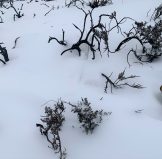
(Durango Before and After Fire. Photo Credit: Colorado State Forest Service.)
After the Fire
We are so grateful that nearly all the folks in the Marshall Fire burn area were able to evacuate quickly and safely. The horror of all the lost homes and their contents, the pets trapped, and the gardens obliterated is outweighed by the survival of all but two residents.

Credit, Boulder OEM
But we would like to say a few words in remembrance of Robert Sharpe, who perished in the fire. Robert was a longtime friend and frequent visitor to Harlequin’s Gardens, always very congenial and enthusiastically supportive of our mission. We often ran into him at public dances, concerts, environmental events, and of course, McGuckin Hardware. We also appreciated that he volunteered at our community radio station, KGNU and frequently participated in KGNU’s call-in discussions on a wide range of topics, bringing thoughtful questions and perspectives. He will not be forgotten.
Suggestions for Remediating Singed and Burned Gardens
 Since the fire, we have received questions about how to remediate and revive singed and burned gardens, plants and soil. We don’t have personal experience in this area, but we do have some ideas that we think will help.
Since the fire, we have received questions about how to remediate and revive singed and burned gardens, plants and soil. We don’t have personal experience in this area, but we do have some ideas that we think will help.
The primary agents for remediation of soils, and for regenerating damaged plants after fire are the application and feeding of Soil Biology and the application of organic fertilizers.
 The deciduous shrubs that lose their leaves can be cut back in the spring when you see the new growth-just cut off the dead then. Evergreens are harder: if they are singed, the advice is the same: wait until spring and cut off the dead. In both cases, some shaping may be necessary. With more extensive burned areas on evergreens, if the damage is considerable, you will have to decide whether you can wait for regrowth. Evergreens often will not put on new growth on old wood (unlike deciduous shrubs which can grow back from stumps). If too much of the evergreen is burned, it may not be possible to save, and will have to be replaced.
The deciduous shrubs that lose their leaves can be cut back in the spring when you see the new growth-just cut off the dead then. Evergreens are harder: if they are singed, the advice is the same: wait until spring and cut off the dead. In both cases, some shaping may be necessary. With more extensive burned areas on evergreens, if the damage is considerable, you will have to decide whether you can wait for regrowth. Evergreens often will not put on new growth on old wood (unlike deciduous shrubs which can grow back from stumps). If too much of the evergreen is burned, it may not be possible to save, and will have to be replaced.
 It would be good to apply an organic fertilizer. A liquid fertilizer with no more than 8% nitrogen and with kelp added, like Age Old Fish & Seaweed, or their Grow formula, and Neptune’s Harvest Fish & Seaweed, will be good for quick uptake and response for the new growth. At the same time apply a granular organic fertilizer with no more than 8% Nitrogen for slow acting benefit lasting for several months. Water this in. Then when temperatures are in the 50s, apply compost tea with the liquid organic fertilizer every 2-4 weeks for a couple of months. Mulch 2″ when the cold weather is over.
It would be good to apply an organic fertilizer. A liquid fertilizer with no more than 8% nitrogen and with kelp added, like Age Old Fish & Seaweed, or their Grow formula, and Neptune’s Harvest Fish & Seaweed, will be good for quick uptake and response for the new growth. At the same time apply a granular organic fertilizer with no more than 8% Nitrogen for slow acting benefit lasting for several months. Water this in. Then when temperatures are in the 50s, apply compost tea with the liquid organic fertilizer every 2-4 weeks for a couple of months. Mulch 2″ when the cold weather is over.
This approach should also help build soil biology and strengthen the plants to regrow and recover their health. High nitrogen chemical fertilizers are not recommended because they will suppress the soil biology and put growth ahead of health.
The CSU Extension offers articles on landscape remediation for fire and smoke-affected plants and soils on their website.
